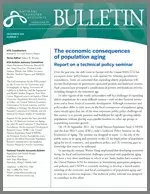Error message

Additional titles in the NTA Bulletin series NTA measures the direct effect of population age structure on economic growth in terms of the support ratio--the effective number of producers relative to the effective number of consumers. The support ratio changes in a systematic way over the demographic transition, as first the working-age population and then the elderly population increase in size relative to other age groups. Over the next 20 years, many developing economies will experience large increases in their support ratios as their working-age populations expand. One immediate challenge for policymakers is to insure that the increase in the potential workforce leads to greater employment in productive jobs. In industrialized economies, where the support ratio has reached its peak or has already begun to decline, policymakers face two challenges. The first is how best to sustain economic growth with a decline in the number of workers relative to other age groups, and the second is how to sustain or reform public programs that address the needs of growing elderly populations. Seminar participants discussed the impact of population aging on pension and healthcare systems, including forecasts of rising expenditures and the pros and cons of various approaches to contain costs. Much of the discussion also focused on the macro-economic effects of population aging, including structural changes in markets and the impact of older populations on patterns of saving and investment. The participants did not agree on one important question: Whether higher saving or higher consumption is better for economic growth. They did agree, however, that increased saving in the midst of a deep recession is unlikely to lead to more rapid economic growth and that creating a favorable investment environment is essential to meeting the needs of an aging society.
|
Additional titles in the NTA Bulletin series NTA measures the direct effect of population age structure on economic growth in terms of the support ratio--the effective number of producers relative to the effective number of consumers. The support ratio changes in a systematic way over the demographic transition, as first the working-age population and then the elderly population increase in size relative to other age groups. Over the next 20 years, many developing economies will experience large increases in their support ratios as their working-age populations expand. One immediate challenge for policymakers is to insure that the increase in the potential workforce leads to greater employment in productive jobs. In industrialized economies, where the support ratio has reached its peak or has already begun to decline, policymakers face two challenges. The first is how best to sustain economic growth with a decline in the number of workers relative to other age groups, and the second is how to sustain or reform public programs that address the needs of growing elderly populations. Seminar participants discussed the impact of population aging on pension and healthcare systems, including forecasts of rising expenditures and the pros and cons of various approaches to contain costs. Much of the discussion also focused on the macro-economic effects of population aging, including structural changes in markets and the impact of older populations on patterns of saving and investment. The participants did not agree on one important question: Whether higher saving or higher consumption is better for economic growth. They did agree, however, that increased saving in the midst of a deep recession is unlikely to lead to more rapid economic growth and that creating a favorable investment environment is essential to meeting the needs of an aging society.
|





